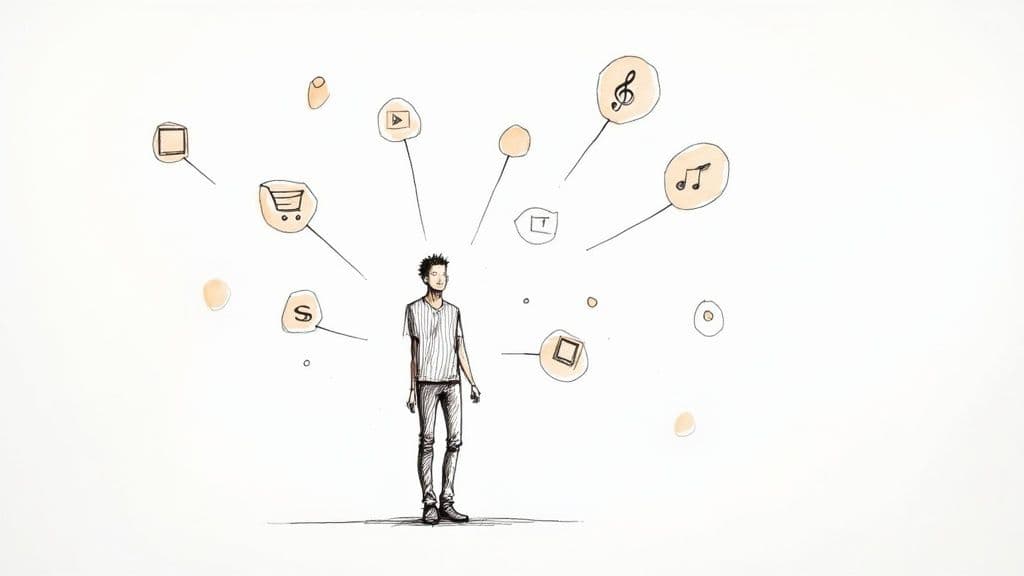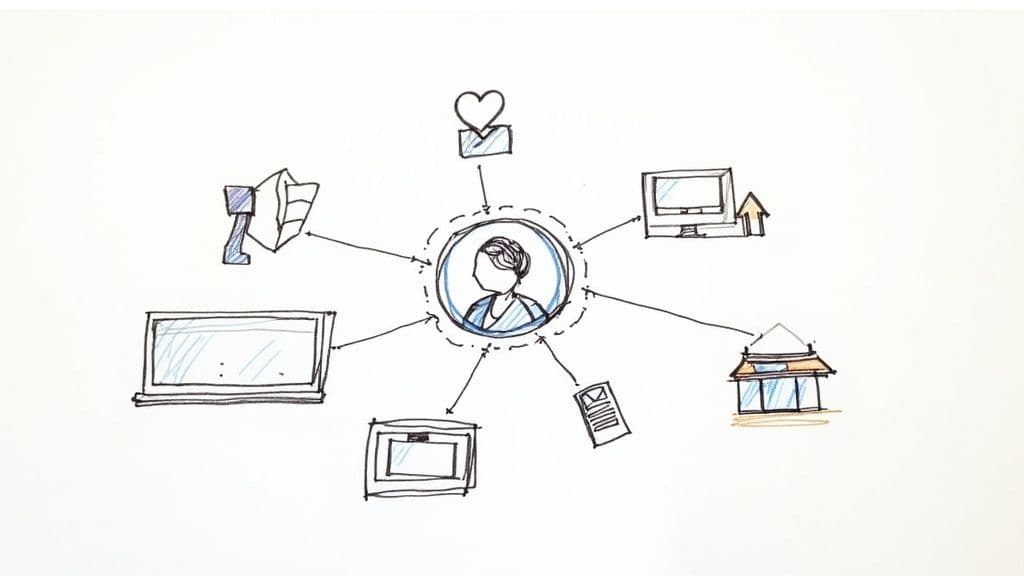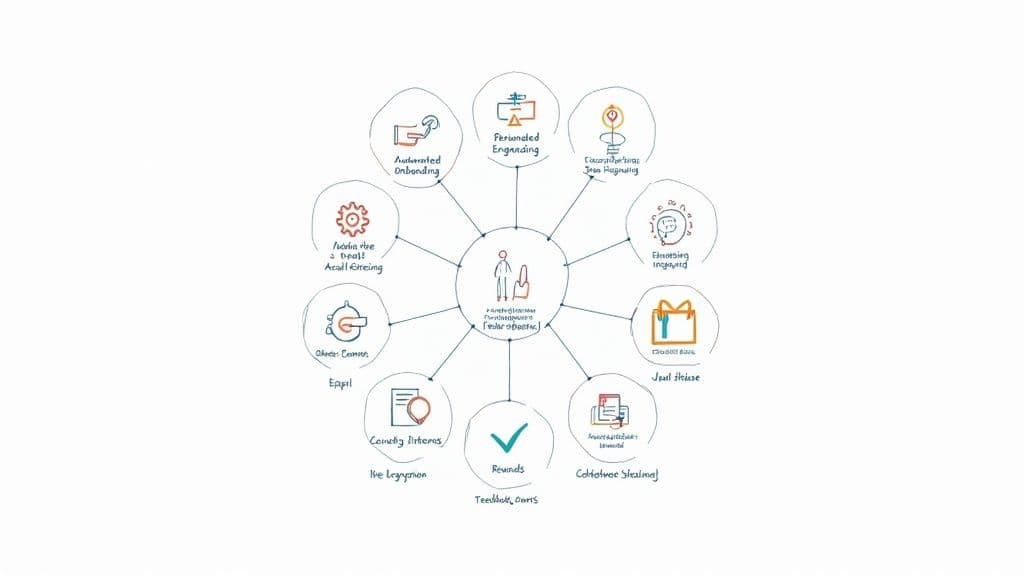In the world of creators and subscription-based businesses, the race to acquire new customers can often overshadow a more critical, profitable strategy: keeping the ones you have already earned. While growth is essential, true long-term success is built on a foundation of loyalty. High churn rates can silently sink even the most promising ventures, forcing you into an expensive and exhausting cycle of acquisition. This is where mastering customer retention becomes your competitive advantage.
This guide moves beyond generic advice to detail eight actionable customer retention best practices. We will explore specific, field-tested strategies you can implement immediately to build a resilient, thriving community and a predictable revenue stream. You will learn how to personalise the member journey, provide proactive support, and optimise your onboarding process to foster genuine loyalty.
For creators using platforms like Telegram to build their communities, these practices are not just helpful-they are essential for transforming followers into lifelong members. Applying these methods will help you deliver exceptional value and secure your business's future. Let's explore the strategies that create customers who choose to stay, month after month.
1. Personalized Customer Experience
Personalising the customer experience involves creating tailored interactions based on an individual's preferences, behaviour, and purchase history. Instead of a one-size-fits-all approach, this strategy treats each subscriber as unique, delivering relevant content and recommendations that resonate deeply with their specific interests. This is a cornerstone of modern customer retention best practices because it makes subscribers feel seen and valued, fostering a strong sense of loyalty.

a4185aaf-74cd-41a2-ab63-ec70bc08eb5a.jpg
This method moves beyond simply using a customer's first name in an email. It’s about leveraging data to provide genuine value. For instance, Netflix excels at this by customising its entire user interface, from content recommendations to thumbnail artwork, based on viewing habits. Similarly, Spotify’s "Discover Weekly" playlists are a prime example of successful personalisation, introducing users to new music they are likely to enjoy and keeping them engaged with the platform.
How to Implement a Personalised Experience
To effectively integrate personalisation, focus on gathering and utilising customer data across all touchpoints. This ensures a cohesive and relevant experience whether they are on your website, receiving an email, or interacting with your app.
- Start with Segmentation: Begin by grouping your audience based on shared characteristics like purchase history, engagement level, or subscription tier. For a fitness coach, this could mean segmenting clients into "beginner," "intermediate," and "advanced" groups to send tailored workout plans.
- Utilise Progressive Profiling: Avoid overwhelming new subscribers with lengthy sign-up forms. Instead, gather information gradually through quizzes, surveys, or by tracking their interactions with your content over time.
- Leverage Behavioural Data: Track how users engage with your service. An online course instructor could note which modules a student revisits most often and then recommend supplementary materials on that specific topic.
- Automate Communications: Use marketing automation tools to send triggered messages based on user actions, such as a personalised welcome series for new subscribers or a special offer on their subscription anniversary.
2. Proactive Customer Support
Proactive customer support involves anticipating customer needs and resolving potential issues before they escalate or even arise. Instead of waiting for a customer to report a problem, this strategy uses data and behavioural monitoring to identify friction points and offer assistance preemptively. This is one of the most effective customer retention best practices because it demonstrates that you are actively invested in your subscriber's success, creating a seamless and frustration-free experience that builds profound trust.

b4b6888c-5506-4957-b489-a99b704afa2e.jpg
This approach shifts support from a reactive function to a value-driving one. For example, HubSpot's customer success teams famously reach out to users whose platform usage drops, offering guidance before they consider churning. Similarly, Shopify proactively alerts its merchants to potential security vulnerabilities or performance issues, helping them protect their online stores. These actions prevent negative experiences and reinforce the platform's value, making subscribers less likely to leave.
How to Implement Proactive Customer Support
To effectively integrate proactive support, you need to analyse customer data to predict challenges and establish workflows to address them before the customer reaches out for help. This transforms your support from a cost centre into a retention engine.
- Use Data to Predict Problems: Monitor user behaviour to identify patterns that often precede a support ticket or cancellation. For a subscription box service, this could be tracking delivery statuses and proactively notifying a customer of a delay with an explanation and a small credit.
- Create Automated Proactive Workflows: Set up automated triggers for common scenarios. An online course provider could automatically send a helpful video tutorial to a student who has spent an unusually long time on a single lesson, assuming they might be stuck.
- Train Teams to Spot Early Warnings: Equip your support and success teams to recognise subtle signs of customer frustration or confusion during their interactions. This includes flagging accounts with decreasing engagement or repeated minor issues.
- Measure Proactive Impact: Track how your proactive interventions affect key metrics. Monitor churn rates, customer satisfaction scores, and lifetime value for cohorts who received proactive support versus those who did not to prove its ROI.
3. Customer Loyalty Programs
Customer loyalty programmes are structured marketing strategies designed to encourage customers to continue engaging with a business. By offering rewards, discounts, or exclusive access based on their purchase frequency or engagement level, these programmes create a powerful incentive for repeat business. This is a vital customer retention best practice because it systematically rewards loyalty, making subscribers feel appreciated and giving them a compelling reason to stay.

a4d35ffc-fa51-4fd9-8f21-12b67857a661.jpg
These programmes transform transactional relationships into emotional connections. For instance, Sephora's Beauty Insider programme offers tiered rewards, exclusive products, and community events, making members feel like part of a special club. Similarly, Starbucks Rewards integrates mobile ordering with a points system that provides free drinks and food, seamlessly weaving the programme into the customer's daily routine and reinforcing brand allegiance with every purchase.
How to Implement a Customer Loyalty Programme
An effective loyalty programme must be simple, valuable, and well-integrated into the overall customer experience. For creators, this could be the foundation of a thriving community. If you're looking to build a structured community platform, you can learn more about how to create a membership site on MyMembers.io.
- Design Relevant Rewards: Align rewards with what your audience truly values. A fitness coach could offer a free one-on-one virtual session after ten group classes, while a content creator might provide exclusive behind-the-scenes content to their most loyal subscribers.
- Keep It Simple: Ensure the programme is easy to understand and join. A complex points system can deter participation. A straightforward "buy nine, get the tenth free" model or a simple tiered system (e.g., Bronze, Silver, Gold) often works best.
- Communicate Benefits Clearly: Regularly remind members of their status, the rewards they have earned, and what they can unlock next. Use email, in-app notifications, or a dedicated members' area to keep them engaged with the programme.
- Integrate Across All Touchpoints: Your loyalty programme should feel like a natural part of interacting with your brand, whether a subscriber is on your website, in your community group, or viewing your content.
4. Regular Customer Feedback Collection and Action
Actively collecting and acting on customer feedback involves creating systems to gather opinions, experiences, and suggestions through multiple channels. The strategy's power lies not just in listening, but in using that intelligence to make meaningful improvements to your product, service, or community experience. This is a vital customer retention best practice because it shows subscribers their voice matters, transforming them from passive consumers into active partners in your brand's evolution.

2ee23b93-d957-4cee-bafb-e560e029b760.jpg
This process builds a continuous improvement loop that strengthens your offering and deepens customer relationships. For instance, Slack consistently integrates user feedback into its product development, rolling out features and fixes that directly address user requests. Similarly, Airbnb's post-stay review system provides a transparent feedback mechanism that builds trust and helps both hosts and the platform refine the guest experience, leading to higher satisfaction and repeat bookings.
How to Implement Customer Feedback Systems
To effectively embed this practice, you must systematise both the collection and the implementation of customer insights. The goal is to make feedback a routine part of the customer lifecycle, not a one-off campaign.
- Use Multiple Feedback Channels: Don't rely on a single method. Combine Net Promoter Score (NPS) surveys, short in-app polls, suggestion forms, and one-on-one interviews to capture a diverse range of opinions. A Telegram channel owner could use quick polls to gauge content preferences.
- Automate Collection at Key Moments: Trigger feedback requests at critical points in the customer journey. An online course instructor could automatically send a survey after a student completes a major module or finishes the entire course.
- Keep Surveys Short and Focused: Respect your customers' time. Ask concise, relevant questions that provide actionable data. Avoid long, generic surveys that lead to high drop-off rates and low-quality responses.
- Close the Feedback Loop: This is the most crucial step. When you implement a change based on feedback, communicate it back to your audience. Announce the update in your community, send an email, and thank users for their input to show you are listening and taking action.
5. Value-Added Services and Content
Providing value-added services and content means offering extra resources, tools, or educational materials that enhance your core subscription. Instead of only focusing on the primary product, this strategy enriches the overall customer experience with complementary offerings that solve adjacent problems for your audience. This is a powerful customer retention best practice because it deepens the user's relationship with your brand, making your service indispensable to their broader goals.
This approach positions you as an expert and a partner, not just a service provider. For example, HubSpot’s free HubSpot Academy offers extensive training on marketing and sales, helping users succeed far beyond just using their software. Similarly, Patagonia reinforces its brand mission with environmental activism content and outdoor education, giving customers more reasons to feel connected to the brand. These additions make subscribers feel they are getting more value than they paid for, strengthening their loyalty.
How to Implement Value-Added Offerings
To successfully integrate value-added content, you must align these free resources with your subscribers' core challenges and aspirations. The goal is to provide genuine utility that supports their journey and reinforces the value of your main offering.
- Align with Customer Goals: Identify the primary objectives of your subscribers. A digital coach for entrepreneurs could offer free downloadable templates for business plans or cash flow projections, directly supporting their clients' success.
- Showcase Your Expertise: Create content that demonstrates your authority while providing tangible benefits. An online course instructor might host free monthly webinars on advanced topics or create a resource library with industry reports and case studies.
- Integrate into the Customer Journey: Weave your value-added services into the subscriber experience. A fitness trainer could include a free nutrition guide as part of their onboarding sequence or grant access to an exclusive community forum for members to share progress.
- Gather Feedback for Optimisation: Use surveys and engagement data to determine which resources your audience finds most useful. Ask your Telegram channel members what kind of exclusive content they would most appreciate, then deliver on their requests.
6. Customer Success Management
Customer Success Management is a proactive business methodology focused on helping customers achieve their desired outcomes while using your product or service. Rather than simply reacting to problems, this approach involves dedicated managers who work with customers to ensure they realise maximum value, overcome challenges, and meet their goals. This is one of the most powerful customer retention best practices because it shifts the dynamic from a transactional relationship to a strategic partnership, significantly reducing churn.
This strategy is about ensuring your solution becomes indispensable to the customer's success. For example, Slack’s customer success teams don’t just sell a tool; they help organisations optimise their internal communication workflows, making the platform integral to their operations. Similarly, Salesforce provides a robust customer success platform that includes health scores and renewal forecasting, enabling businesses to proactively manage their client relationships and drive growth. Effective customer success management relies heavily on streamlined internal operations and collaborative teamwork. To see how optimising your internal processes can directly support these efforts, you can explore some Notion for Teams Best Practices to enhance teamwork.
How to Implement Customer Success Management
Building an effective customer success function requires a structured, data-driven approach that aligns with your customers' goals and your business outcomes. The aim is to create predictable, positive results for your members.
- Define Success Metrics: Work with your customers to understand what success looks like for them. For a fitness coach, this could mean defining milestones like "run a 5K in under 30 minutes" or "achieve 15% body fat."
- Implement Health Scoring: Create a customer "health score" based on engagement data, such as login frequency, feature usage, and support ticket volume. This allows you to identify at-risk customers before they churn.
- Develop Standardised Playbooks: Create clear, repeatable processes for common scenarios like onboarding, goal-setting reviews, and renewal conversations. This ensures consistency and scalability.
- Align with Business Outcomes: Ensure your customer success efforts are directly tied to key business metrics like retention rates, upsell revenue, and net promoter score (NPS). This demonstrates the value of your programme. You can find more details on how this integrates into broader membership growth strategies on MyMembers.io.
7. Omnichannel Communication Strategy
An omnichannel communication strategy creates a seamless, integrated customer experience across all touchpoints. Unlike a multichannel approach, which simply uses various platforms, an omnichannel strategy ensures that messaging, branding, and service quality are consistent whether customers interact via email, social media, a mobile app, or in person. This is a vital component of customer retention best practices because it allows subscribers to move between channels without friction, reinforcing a sense of reliability and trust in your brand.
This strategy is about channel integration, not just channel presence. For instance, Disney’s MagicBand system expertly unifies the theme park, hotel, and mobile app experiences, allowing for a fluid journey. Similarly, a creator using a platform like Telegram for their community can integrate it with their email newsletters and course portal, ensuring members receive consistent updates and support regardless of where they engage. For a holistic approach to ensuring consistent and impactful interactions, consider learning more about developing an effective communication plan and strategy.
How to Implement an Omnichannel Strategy
To build a successful omnichannel experience, you must unify your customer data and align your team to deliver a consistent service level across all platforms. This ensures subscribers feel understood no matter how they choose to connect.
- Map the Customer Journey: Identify every touchpoint a subscriber has with your service, from initial sign-up to daily engagement. A fitness coach might map interactions across their app, weekly emails, and private social media groups.
- Invest in a Unified Platform: Use a central system or integrated tools to manage customer data. This gives you a single view of each subscriber's history, preferences, and interactions, preventing disjointed communication.
- Train for Cross-Channel Support: Ensure your support team is equipped to handle queries that start on one channel and move to another. For example, a query that begins in a Telegram group chat might need to be resolved via a one-on-one email.
- Test the Experience Regularly: Continuously test the flow between your channels from a customer's perspective. For example, try to use a discount code from an email on your mobile app to ensure the process is smooth and intuitive.
8. Customer Onboarding Optimisation
Customer onboarding optimisation is the process of guiding new users to find value in your product or service as quickly and smoothly as possible. A strong onboarding experience is a critical customer retention best practice because it sets the foundation for a long-term relationship. It helps subscribers understand how to use your offering effectively, achieve an early success, and clearly see the benefits they signed up for, drastically reducing the chances of early churn.

embed
This initial interaction is your first and best chance to prove your subscription's worth. For example, the language learning app Duolingo uses a gamified onboarding process that gets users learning their first words within minutes, providing immediate positive reinforcement. Similarly, Slack introduces features gradually as users interact with the platform, avoiding overwhelm and teaching contextually. These approaches ensure users don't feel lost or frustrated, making them more likely to integrate the service into their daily lives.
How to Implement Customer Onboarding Optimisation
To create a powerful onboarding flow, focus on guiding users to their "aha!" moment, the point where they truly understand the value you provide. This requires a thoughtful, user-centric approach that is continuously measured and improved.
- Focus on the First Win: Design your onboarding to help the customer achieve one key outcome quickly. A social media scheduler, for instance, should guide a new user to schedule their very first post, demonstrating immediate value.
- Use Progressive Disclosure: Don't show every feature at once. Introduce advanced functionalities only after the user has mastered the basics. A fitness coach's app could unlock meal planning features after a user has consistently logged workouts for a week.
- Personalise the Journey: Tailor the onboarding experience based on the user's stated goals. Ask new subscribers what they want to achieve, then customise the initial steps to align with their specific use case, whether that's "build muscle" or "improve cardio."
- Offer Multiple Formats: Cater to different learning preferences by providing a mix of onboarding tools. This could include interactive product tours, short video tutorials, a comprehensive knowledge base, and personalised welcome emails.
Customer Retention Best Practices Comparison
| Item | Implementation Complexity 🔄 | Resource Requirements ⚡ | Expected Outcomes 📊 | Ideal Use Cases 💡 | Key Advantages ⭐ |
|---|---|---|---|---|---|
| Personalized Customer Experience | High – requires data infrastructure and privacy management | High – data collection, real-time engines | Increased satisfaction, engagement, and conversion | Businesses with rich customer data and multiple touchpoints | Strong emotional connections, targeted messaging |
| Proactive Customer Support | High – involves advanced monitoring and predictive analytics | High – technology and training investment | Reduced churn, fewer support tickets, higher CSAT | SaaS, tech companies, complex products | Prevents issues proactively, demonstrates care |
| Customer Loyalty Programs | Medium – manageable systems like points and tiers | Medium – ongoing reward management | Increased lifetime value and purchase frequency | Retail, subscription services | Drives repeat business, competitive differentiation |
| Regular Customer Feedback Collection and Action | Medium – requires multi-channel systems and analysis | Medium – staff and tools for analysis | Identifies issues early, improves products and CX | Product-driven businesses, service providers | Data-driven improvements, customer engagement |
| Value-Added Services and Content | Medium – content creation and service integration | Medium – investment in resources and expertise | Higher engagement, brand authority | Brands focusing on thought leadership | Builds trust and differentiation |
| Customer Success Management | High – dedicated teams and sophisticated monitoring | High – personnel and tech resources | Reduced churn, upsell opportunities, stronger relationships | B2B SaaS, subscription models | Proactive engagement, scalable growth |
| Omnichannel Communication Strategy | Very High – complex system integration and synchronization | High – technology and training | Consistent, seamless experience, improved efficiency | Large enterprises with multiple channels | Unified customer view, improved service quality |
| Customer Onboarding Optimization | Medium – guided processes and support resources | Medium – design and maintenance effort | Faster time-to-value, reduced early churn | SaaS, complex products, new user bases | Accelerates adoption, reduces support load |
Turn Retention into Your Greatest Growth Engine
Navigating the landscape of customer retention can feel complex, but as we've explored, it boils down to a fundamental principle: consistently delivering exceptional value and fostering genuine relationships. The eight customer retention best practices detailed in this article are not isolated tactics; they are interconnected pillars that support a robust, customer-centric business model. From the crucial first impression set by an optimised onboarding process to the ongoing dialogue facilitated by proactive support and regular feedback collection, each strategy builds upon the last.
Think of it as a flywheel. A personalised customer experience makes members feel seen and valued, which encourages them to engage with your loyalty programmes. When they feel rewarded, they are more likely to provide honest feedback, which you can then use to develop new value-added content or enhance your customer success management. This continuous loop of positive engagement and improvement is what transforms passive subscribers into passionate advocates for your brand, creating a sustainable and cost-effective growth engine fuelled by loyalty.
Key Takeaways and Your Next Steps
The journey to mastering customer retention is ongoing, but the path forward is clear. The most critical takeaway is that retention is an active, not a passive, endeavour. It requires a strategic and empathetic approach at every stage of the customer lifecycle.
To put these concepts into action, start by auditing your current processes against the best practices we've discussed:
- Audit Your Onboarding: Is your welcome sequence clear, engaging, and setting subscribers up for success from day one?
- Implement a Feedback Loop: Choose one method, like a simple survey or a dedicated feedback channel, and commit to collecting and acting on customer insights this quarter.
- Review Your Communication: Are you leveraging an omnichannel strategy to meet your members where they are, ensuring seamless and convenient interactions?
Focusing on even one of these areas can yield significant improvements. The goal is not perfection overnight, but consistent, incremental progress. For those looking to dive deeper into actionable tactics and truly make retention your growth engine, explore proven methods on how to increase customer retention for more advanced strategies.
Ultimately, building a loyal community is the most powerful differentiator for any creator or subscription business. By prioritising the relationship over the transaction and consistently applying these customer retention best practices, you are not just preventing churn; you are investing in a future where your most valuable asset is the unwavering support of your customers.
Ready to automate the admin and focus on building your community? MyMembers handles payments, subscriptions, and member access for your Telegram channels and groups, freeing you up to implement these retention strategies effectively. Get started with MyMembers today and turn your passion into a thriving subscription business.
